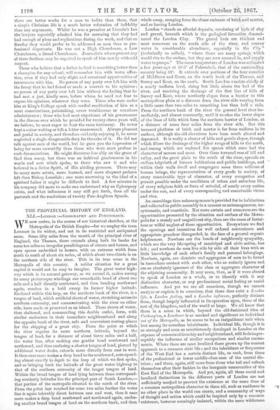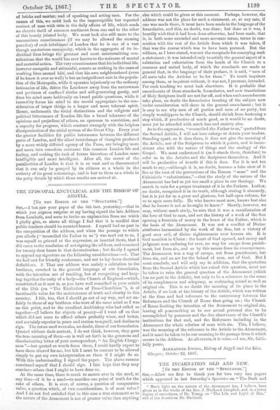THE PROVINCIAL HISTORY OF ENGLAND. XLI.--Losnon :--GEOGRAPHY AND PSYCHOLOGY.
WE now arrive, in the course of our historical sketches, at the Metropolis of the British Empire—for we employ the term LoNnoet in its widest, and not in its restricted and antiquated sense. Some fifty miles from the mouth of the principal river of England, the Thames, there extends along both its banks for some ten miles an irregular parallelogram of streets and houses, and open spaces embedded in houses, with an extreme width from north to south of about six miles, of which about two-thirds is on the northern side of the river. This in its true sense is the Metropolis of this country. A nobler situation for a great capital it would not be easy to imagine. The great water high- way which is its natural gateway, as we ascend it, makes among its many picturesque windings one remarkable bend of about one mile and a half directly southward, and then bending northward again, reaches in a bold sweep its former higher latitude. Enclosed within this loop, on the northern bank of the river, is a tongue of land, which artificial sheets of water, stretching across its northern extremity, and commnnicating with the river on either side, have made or preserved as an island. These sheets of water, thus sheltered, and commanding this double outlet, form, with similar enclosures in their immediate neighbourhood and along the opposite bank of the river, safe and convenient resting-places for the shipping of a great city. From the point at which the river regains its more northern. latitude, beyond the tongue of land, for a distance of about three miles and a half, the water line, after making one gentler bend southward and northward, and thus enclosing a shorter tongue of land, pierced by additional water docks, extends more directly from east to west. It then once more makes a deep bend to the southward, correspond- ing almost exactly in depth to the loop of which we first spoke, and so bringing back the latitude of the great water highway to that of the southern extremity of the longer tongue of land. Within the broad tongue of land lying between these correspond- ing southerly latitudes lies the principal part of South London,— that portion of the metropolis situated to the south of the river. From the point last reached for some two miles farther the water line is again tolerably direct between east and west, then it once more makes a deep bend southward and northward again, enclos- ing another broad tongue of land on the northern bank, and then
there are better works for a man to indite than these that winds away, escaping from the closer embrace of brick and mortar, and so leaving London.
London "stands on alluvial deposits, consisting of beds of clay and gravel, beneath which is the geological formation denomi- nated the London Clay. The gravel beds are thickest and
most numerous on the north side of the river, and convey water in considerable abundance, especially in the City "
(technically so called), "where there are many springs which of these factions may be expected to speak of him merely with cold would rise to the surface, but they are now covered in, and supply water to pumps." The mean temperature of London was estimated a few years ago at 50-5° of Fahrenheit, that of the surrounding country being 48°. It extends over portions of the four counties of Middlesex and Essex, on the north bank of the Thames, and Surrey and Kent, on the south. South Loudon consists chiefly of a nearly uniform level, rising but little above the bed of the river, and receiving the drainage of the first line of bills of Surrey and Kent, whose northerly slopes form a barrier to this metropolitan plain at a distance from the river side varying from a little more than two miles to something less than half a mile. From the northern bank of the river the general level rises im- mediately, and almost constantly, until it reaches the lower slopes of the lines of hills which form the northern barrier of London, at a distance of some four miles from the river side. But this terraced platform of brick and mortar is far from uniform in its surface, although the old elevations have been much altered and depressed. It is really a cluster of hills and gentle slopes, through which filters the drainage of the higher range of bills to the north, and among which are enclosed flat spaces which once had the character of morass and moor. Over these terraced seas of hill and valley, and the great plain to the south of the river, spreads an endless labyrinth of human habitations and public buildings, and within their walls dwell and congregate some three millions of human beings, the representatives of every grade in society, of every conceivable type of character, of every occupation and pursuit possible under the conditions of urban and suburban life, of every religious faith or form of unbelief, of nearly every nation under the sun, and of every corresponding and conceivable virtue and vice.
An assemblage thus unhomogeneous is provided for in habitations and collected in public assembly in a manner as unhomogeneous, un- systematic, and umulistic. Not more certain and numerous are the opportunities presented by the situation and surface of the Metro- polis for a stately and magnificent city, than are the cases of fortui- thus or wilful neglect of these opportunitieA. Everywhere we find the openings and incentives for well ordered convenience and appropriate grandeur disregarded, in the face of a general organic helplessness. Nowhere are the bonds of neighbourly sympathy, which are the very lifelspring of municipal and civic action, less felt ; and nowhere do men live side by side all their lives with so little knowledge of each other's family and personal belongings. Nowhere, again, are districts and aggregates of men to be found in immediate contact with each other, who so entirely ignore and are so absolutely ignorant of the class or aggregate character of the adjoining community. It may seem, then, as if it were absurd to speak of London a.s .a whole, or to identify with it any distinctive character, or any predominant social feeling or social influence. And yet we are all conscious, though we cannot analyze or explain it to ourselves, that there does exist a London life, a London feeling, and a London influence, perfectly distinct from, though largely influential in its operation upon, those of the rest of. the kingdom, and of the world at large. We all know that there is a sense in which, beyond the old-fashioned idea of Cockneyism, a Londoner is as marked and significant an individual out of the _Metropolis, as he seems to be an insignificant unit when lost among its countless inhabitants. Individual life, though it is so strongly and even so mischievously developed in London at the expense of common citizenship and neighbourhood, still feels imper- ceptibly the influence of similar occupations and similar amuse- ments. Where these are most localized there grows up the nearest approach to a common civic life ; and the inhabitant or frequenter of the West End has a certain distinct life, as such, from those of the professional or lower middle-class man of the central dis- tricts; and these, again, still more from those who toil and refresh themselves after their fashion in the inorganic communities of 'the East End of the Metropolis. And yet, again, all these social and localized distinctions in the different parts of London are not sufficiently marked to prevent the existence at the same time of a common metropolitan character in them all, such as residence in no other place in the world can create, and a community of ways of thought and action which could be inspired only by a common existence, however seemingly isolated, within the same wilderness of bricks and mortar,-and of speaking and acting men. For the causes of this, we miat look to the imperceptible but repeated contact of man with thin in the daily affairs of life, which sends an electric thrill of cOmmon sentiment from one end to the other of this loosely jointed body. We must look also still more to the unconscious consciousness (if we may be allowed the seeming paradox) of each inhabiRmt of London that he is one of a vast though mysterious community, which in the aggregate of its in- dividual lives brings the greatest and most unintermittiug con- tributions that the world has ever known to the universe of mental and material action. The very consciousness that his individual life, however energetic and successful, counts as nothing in the mass of working lives around him; and that his own neighbourhood (even if he knew it ever so well) is but an insignificant unit in the popula- tion of the Metropolis, while it operates injuriously on the ordinary intimacies of life, drives the Londoner away from the narrowness and pettiness of confineaccireles and self-generating gossip, and fixes his mind more habitually on broad public questions, while it insensibly forms his mind in the mould appropriate to the con- eideration of larger things in a larger and more tolerant spirit. Hence, underneath thelsocial distinctions and the religious and political bitternesses of -London life lies a broad tolerance of the opinions and prejudices of others, an openness to conviction, and a capacity for progress, which contrast strangely with the helpless disorganization of the social system of the Great City. Every year the greater facilities for public intercourse between the different parts of London, and the silent interchange of thoughts produced by a more widely diffused agency of the Press, are bringing more and more into conscious existence this common London life and feeling, and making the task of future historians of London more intelligible and more intelligent. After all, the secret of the peculiarities of London is that it is so vast and so disconnected that it can only be grasped by its citizens as a whole in the entirety of its great outcomings, and is lost to them as a whole in the petty details by which those results are arrived at.



































 Previous page
Previous page